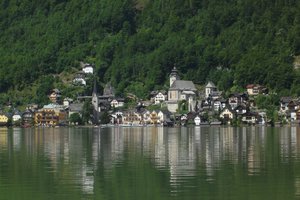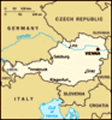Advertisement
Published: June 15th 2013

 Hallstatt
Hallstatt
Across the lake by boat or around the road from Obertraun. Very tourist. Very picturesque.Today is a rest day after many consecutive days of biking. The body is saying enough is enough but that doesn't mean doing nothing.
We walked from Obertraun to the Hallstatt railway station which is about a 45minute walk. From the Schiffstation (ferry stop), we took the ferry across the lake to Hallstatt which is a UNESCO World Heritage Site because of it's unique position and history. It sits right on the lakeside between the water and the cliffs which doesn't allow for much room for a village which is essentially carless. Hallstatt is known for its production of salt dating back to prehistoric times, and gave its name to the Hallstatt Culture, a culture often linked to Early Iron Age Europe. It's human history appears to go back 7000 years still based on the trading of salt. The salt trade is still going but it is mined quite differently. See later.
We arrived in Hallstatt after a short ferry ride across the mirror flat lake. Firstly we wandered through the town looking at the well kept buildings no doubt funded through UNESCO. We noted in this area that people espalier trees onto their houses and weave them around
the windows - maybe through lack of space?
Under the sports shop in the town, they discovered some archeological remains while doing some excavations for the building. There they found Roman remains and many metal and ceramic fragments as well as burial sites. It was fascinating. But best of all, upstairs in the shop was a large fossil and mineral collection that I drooled over but only bought some salt rock.
It has been a very warm and sunny day so we found a tree to sit under for our picnic lunch. TTAT's don't do café lunches unless a treat is needed. Our packed lunches are doing very nicely.
From there we headed uphill in the funicular and then a lift to take us to the Salt Mines. It was a guided tour and was enjoyable as well as informative. We all had to put on overalls of green, blue or maroon and then headed several hundred metres into the mountain through various tunnels where the temperature was 8 degrees. The Guide gave us an overview at each site as well as audio-visual commentaries. We were shown how the miners used to work, what archaeological finds there
have been, a geological history and what is happening now. The highlights were the fun bits of sliding down long wooden slides to levels below. This was the quick way that miners accessed different tunnels. There were two of these and with the last one we were photographed - 64metres downhill at 27.4 km/hr. We also exited the tunnels on a funny little narrow train that we sat astride.
An interesting discovery was made in the mine of a "Man in Salt" who was discovered in 1734. The body of an Celtic salt miner, about 2,500 years old, was preserved by the salt and was a sensation. Unfortunately it cannot be seen, as it does not exist any more. The body was preserved by the salt, but when it was brought to the church in Hallstatt, it started to rot and smell. The people did not know what to do with the body and so they buried it. Unfortunately, because they were Catholic, they thought it was impossible to bury him in the cemetery, because he was a heathen. So they buried the corpse outside of the cemetery and the extraordinary discovery is lost for science.
Essentially the

 A wonderful find in Hallstatt
A wonderful find in Hallstatt
This shop not only had minerals and fossils but an archaeological site in the basement. Well worth a visithuge salt deposit was formed by an inland sea that dried up over a long period and was finally incorporated into mountain building about 250MYrs ago. The rock is made up of up to 70% salt and the rest is clay. Today, instead of mining it as rock, it is dissolved out into water and transported by pipe to Ebensee where it is evaporated and turned into salt as we know it. The tour took over an hour and it was after 3pm by the time we got out so we figured there wasn't much point in doing a further activity. Instead we walked back to Obertraun via the footpath alongside the road.
It has been a hot day which attracts big clouds later in day which meant a downpour in the evening.
Our dinner was good as expected with turkey and pasta done with a sweet and sour pepper sauce followed by tiramisu. A liquer of red wine followed to farewell the 4 Americans who are moving on to Ebensee. It is very international at dinner time with English, Chilean, Ukrainian, South Africans and Kiwis present.
Advertisement
Tot: 0.071s; Tpl: 0.014s; cc: 12; qc: 26; dbt: 0.0461s; 1; m:domysql w:travelblog (10.17.0.13); sld: 1;
; mem: 1.1mb









